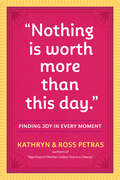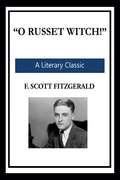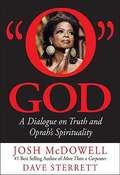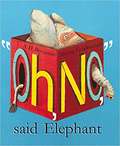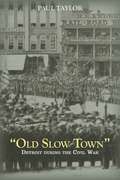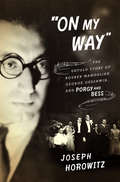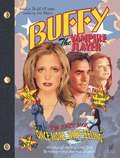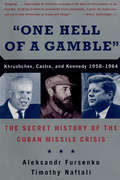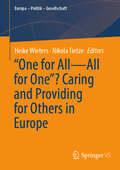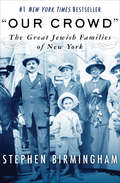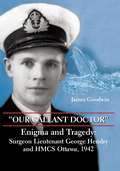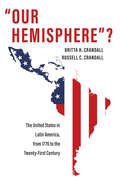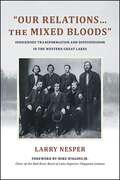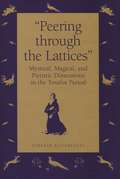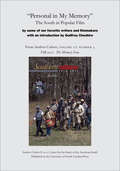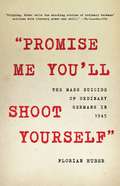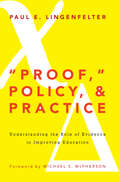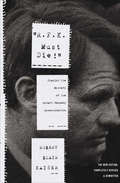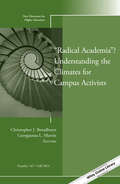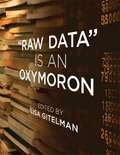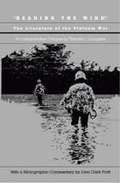- Table View
- List View
"Nothing Is Worth More Than This Day.": Finding Joy in Every Moment
by Ross Petras Kathryn PetrasA book of inspirational quotations, Nothing Is Worth More Than This Day presents hundreds of reminders from some of the smartest people who ever lived—from Dr. Seuss to Erma Bombeck, Thich Nhat Hanh to Lena Dunham—that happiness is everywhere and the glass is half-full. It’s the perfect gift of optimism, for good times and not-so-good times.
"O Russet Witch!"
by F. Scott FitzgeraldShocking in a clever, poignant way, this story is about a pitiful young guy who falls in love from afar with a beautiful, wealthy, young and vivacious girl with russet red hair. A seemingly chance run-in with her has a profound impact on the rest of his life.
"O" God: A Dialogue On Truth And Oprah's Spirituality
by Josh Mcdowell Dave Sterrett"O" God: A Dialogue on Truth and Oprah's Spirituality provides an in-depth look at one of the greatest media influences of all time: the empire of Oprah. Between The Oprah Winfrey Show and O Magazine, millions of people are exposed to Oprah's spiritual beliefs. Christians and those of other faiths are asking tough questions and looking for answers. McDowell and Sterrett approach the spirituality of Oprah by means of a fictional narrative featuring conversation between two friends. The spiritual conversation begins when the two girls get together to discuss spiritual issues. By using stories to address the deeper issues raised in the spiritual discussions held by Oprah and her friends, McDowell and Sterrett disarm and entertain their readers while also revealing biblical truths and exposing the errant teachings and misconceptions of Oprah. Meredith Andrews explains that: "In a day and time when some people feel that truth becomes obscure and moral lines are blurry, 'O' God addresses the popular concept of tolerance, along with other controversial ideas embraced and taught by Oprah herself, in a way that is easily accessible, scripturally based, and lovingly communicated. McDowell and Sterrett do a phenomenal job of comparing and contrasting Oprah's spiritual undertakings with God's Word and helping readers to thoroughly examine the spiritual trends of the day. Completely eye-opening and a must-read." McDowell, a mega-bestselling Christian author and evangelist, teams up with Sterrett, a gifted writer and popular speaker, to broach a serious subject with a wise, balanced, easy-to-read approach. McDowell and Sterrett help readers to discern the truth about the spirituality of Oprah and her friends.
"Oh, No," Said Elephant
by A. H. BenjaminAll the animals want to play hide-and-seek, but– “oh, no!” –Elephant isn't very good at that. He's too easy to find. What about leap-frog? He's not good at that, either. What about hopscotch, or skipping, or tag? No, no and no. Poor Elephant isn't very good at many games, and the animals are starting to get frustrated with him. Luckily there is one game Elephant loves to play, and the animals oblige him, though they may have to say "oh, no!" themselves when he wants to play it again. This rollicking, silly, repetitive text will have young readers laughing out loud and asking to read it again.
"Old Slow Town": Detroit During the Civil War
by Paul TaylorThough it was located far away from Southern battlefields, Detroit churned with unrest during the American Civil War. The city's population, including a large German and Irish immigrant community, mostly aligned with anti-war Democrats while the rest of the state stood with the pro-Lincoln Republicans. The virulently anti-Lincoln and anti-Black Detroit Free Press fanned the city's flames with provocative coverage of events. In "Old Slow Town": Detroit during the Civil War, award-winning author Paul Taylor contends that the anger within Detroit's diverse political and ethnic communities over questions about the war's purpose and its conduct nearly tore the city in two. Taylor charts Civil War-era Detroit's evolution from a quiet but growing industrial city (derisively called "old slow town" by some visitors) to a center of political contention and controversy. In eight chapters, Taylor details topics including the pre-war ethnic and commercial development of the city; fear and suspicion of "secret societies"; issues of race, gender, and economic strife during the war; Detroit's response to its soldiers' needs; and celebration and remembrance at the conclusion of the conflict. Taylor's use of rarely seen military correspondence from the National Archives, soldier and civilian diaries and letters, period articles and editorials from Detroit's Civil War-era newspapers, and his fresh, judicious synthesis of secondary sources results in a captivating depiction of Detroit's Civil War history. Until now, why events occurred as they did in Detroit during the Civil War and what life was like for its residents has only been touched upon in any number of general histories. Readers interested in American history, Civil War history, or the ethnic history of Detroit will appreciate the full picture of the time period Taylor presents in "Old Slow Town."
"On My Way": The Untold Story of Rouben Mamoulian, George Gershwin, and Porgy and Bess
by Joseph HorowitzA revelatory history of the operatic masterpiece that both made and destroyed Rouben Mamoulian, its director and unsung hero. "Bring my goat!" Porgy exclaims in the final scene of Gershwin's opera Porgy and Bess. Bess, whom he loves, has left for New York City, and he's determined to find her. When his request is met with astonishment--New York is a great distance from South Carolina's Catfish Row--Porgy remains undaunted. He mounts his goat-cart and leads the community in an ecstatic finale, "Oh Lawd, I'm on my way." Stephen Sondheim has called "Bring my goat!" "one of the most moving moments in musical theater history." For years it was assumed that DuBose Heyward--the author of the seminal novella and subsequent play, Porgy, and later the librettist for the opera Porgy and Bess--penned this historic line. In fact, both it and "Oh Lawd, I'm on my way" were added to the play eight years earlier by that production's unheralded architect: Rouben Mamoulian. Porgy and Bess as we know it would not exist without the contributions of this master director. Culling new information from the recently opened Mamoulian Archives at the Library of Congress, award-winning author Joseph Horowitz shows that, more than anyone else, Mamoulian took Heyward's vignette of a regional African-American subculture and transformed it into an epic theater work, a universal parable of suffering and redemption. Part biography, part revelatory history, "On My Way" re-creates Mamoulian's visionary style on stage and screen, his collaboration with George Gershwin, and the genesis of the opera that changed the face of American musical life.
"Once More, With Feeling": The Script Book (Buffy the Vampire Slayer)
by VariousGiles (to Buffy): "What did you sing about?" Buffy: "I, uh...don't remember. But it seemed perfectly normal." Xander: "But disturbing. And not the natural order of things and do you think it'll happen again? 'Cause I'm for the natural order of things." Since she's been brought back from the dead (for the second time), Buffy the Vampire Slayer hasn't quite been feeling her calling. Sure, she still gives the underworld a run for its money, but her heart just isn't in the job. Luckily, she's been able to keep her lack of enthusiasm a somewhat secret. Until now. When someone accidentally summons a music-making demon named Sweet, Buffy finds herself belting out her most private emotions. And she's not the only one -- before the battle is done, each of the Scoobies will have uncovered -- through song and dance, for better or for worse, each others' most guarded thoughts -- prompting the question, "where do we go from here?" Here, in one volume, find complete, uncut dialogue, song lyrics, sheet music, and a full-color photo insert. For the true fan, a complete, authorized guide to the smash hit musical episode!
"One Hell of a Gamble": Krushchev, Castro, and Kennedy, 1958-1964
by Timothy Naftali Aleksandr FursenkoBased on classified Soviet archives, including the files of Nikita Khrushchev and the KGB, "One Hell of a Gamble" offers a riveting play-by-play history of the Cuban missile crisis from American and Soviet perspectives simultaneously. No other book offers this inside look at the strategies of the Soviet leadership. John F. Kennedy did not live to write his memoirs; Fidel Castro will not reveal what he knows; and the records of the Soviet Union have long been sealed from public view: Of the most frightening episode of the Cold War--the Cuban Missile Crisis--we have had an incomplete picture. When did Castro embrace the Soviet Union? What proposals were put before the Kremlin through Kennedy's back-channel diplomacy? How close did we come to nuclear war? These questions have now been answered for the first time. This important and controversial book draws the missing half of the story from secret Soviet archives revealed exclusively by the authors, including the files of Nikita Khrushchev and his leadership circle. Contained in these remarkable documents are the details of over forty secret meetings between Robert Kennedy and his Soviet contact, records of Castro's first solicitation of Soviet favor, and the plans, suspicions, and strategies of Khrushchev. This unique research opportunity has allowed the authors to tell the complete, fascinating, and terrifying story of the most dangerous days of the last half-century.
"One for All—All for One”? Caring and Providing for Others in Europe (Europa – Politik – Gesellschaft)
by Heike Wieters Nikola TietzeThis book focusses on how historical dynamics and specific actors have shaped the diverse outlook and everyday practice of welfare in and across Europe. Based on the concept that narratives about welfare in Europe are intricately interconnected with various practices of &“caring&” for oneself and others, the authors take a praxeological approach to analyze specific care activities, the relevant players, and underlying narratives about welfare in Europe in the fields of housing, family provision, social insurance, child care, handling disability, dealing with poverty, and the transition of socialist welfare to the post 1989 world. Welfare is conceptualized as a field of changing relations of co-operation and competition between interest groups (such as labor unions, employers&’ groups, and churches), public government players, and other societal actors (such as social reformers, occupational groups, or NGOs). The volume contributes to the construction of a European multidimensional welfare geography that transcends state institutions and is defined by locally, regionally, nationally, transnationally negotiated and interconnected practices and traditions of caring and providing for others.
"Original Sin," Balance Sheet Crises, and the Roles of International Lending
by Olivier Jeanne Jeromin ZettelmeyerA report from the International Monetary Fund.
"Our Crowd": The Great Jewish Families of New York (Modern Jewish History Ser.)
by Stephen BirminghamThe #1 New York Times bestseller that traces the rise of the Guggenheims, the Goldmans, and other families from immigrant poverty to social prominence. They immigrated to America from Germany in the nineteenth century with names like Loeb, Sachs, Seligman, Lehman, Guggenheim, and Goldman. From tenements on the Lower East Side to Park Avenue mansions, this handful of Jewish families turned small businesses into imposing enterprises and amassed spectacular fortunes. But despite possessing breathtaking wealth that rivaled the Astors and Rockefellers, they were barred by the gentile establishment from the lofty realm of &“the 400,&” a register of New York&’s most elite, because of their religion and humble backgrounds. In response, they created their own elite &“100,&” a privileged society as opulent and exclusive as the one that had refused them entry. &“Our Crowd&” is the fascinating story of this rarefied society. Based on letters, documents, diary entries, and intimate personal remembrances of family lore by members of these most illustrious clans, it is an engrossing portrait of upper-class Jewish life over two centuries; a riveting story of the bankers, brokers, financiers, philanthropists, and business tycoons who started with nothing and turned their family names into American institutions.
"Our Gallant Doctor": Surgeon-Lieutenant George Hendry and HMCS Ottawa, 1942
by James GoodwinDuring the Battle of the Atlantic, Dr. George Hendry had just finished performing two major surgical operations on board the destroyer HMCS Ottawa when his ship was ambushed by 13 German U-boats. Canadian warships like Ottawa had inadequate radar sets that were incapable of detecting submarines approaching in the dark. On September 13, 1942, U-91 stole in and torpedoed Ottawa, sinking her in 20 minutes. utterly exhausted, Dr. Hendry was lost along with 113 of his shipmates. George Hendry was a much-loved man, a great university athlete, and a very good doctor. Unfortunately, he was also naive and too trusting. One night in January 1941, he committed a very foolish indiscretion. He would spend the rest of his tragically short life making amends for this mistake.
"Our Hemisphere"?: The United States in Latin America, from 1776 to the Twenty-First Century
by Russell C. Crandall Britta H. CrandallAn accessible exploration of U.S.–Latin American relations. from the colonial period to the present day &“&‘Our Hemisphere&’? is a balanced and nuanced portrayal of the history of U.S.–Latin American relations. The attention given to more recent episodes on immigration, the drug war and U.S. policy toward Cuba and Venezuela, is especially welcome.&”—Allen Wells, author of Tropical Zion: General Trujillo, FDR and the Jews of Sosúa &“Our Hemisphere&”? uncovers the range, depth, and veracity of the United States&’ relationship with the Americas. Using short historical vignettes, Britta and Russell Crandall chart the course of inter‑American relations from 1776 to the present, highlighting the roles that individuals and groups of soldiers, intellectuals, private citizens, and politicians have had in shaping U.S. policy toward Latin America in the postcolonial, Cold War, and post–Cold War eras. The United States is usually and correctly seen as pursuing a monolithic, hegemonic agenda in Latin America, wielding political, economic, and military muscle to force Latin American countries to do its bidding, but the Crandalls reveal unexpected yet salient regional interactions where Latin Americans have exercised their own power with their northern and very powerful neighbor. Moreover, they show that Washington&’s relationship with the region has relied, in addition to the usual heavy‑handedness, on cooperation and mutual respect since the beginning of the relationship.
"Our Relations…the Mixed Bloods": Indigenous Transformation and Dispossession in the Western Great Lakes (SUNY series, Tribal Worlds: Critical Studies in American Indian Nation Building)
by Larry NesperIn the Great Lakes region of the nineteenth century, "mixed bloods" were a class of people living within changing indigenous communities. As such, they were considered in treaties signed between the tribal nations and the federal government. Larry Nesper focuses on the implementation and long-term effects of the mixed-blood provision of the 1854 treaty with the Chippewa of Wisconsin. That treaty not only ceded lands and created the Ojibwe Indian reservations in the region, it also entitled hundreds of "mixed-bloods belonging to the Chippewas of Lake Superior," as they appear in this treaty, to locate parcels of land in the ceded territories. However, quickly dispossessed of their entitlement, the treaty provision effectively capitalized the first mining companies in Wisconsin, initiating the period of non-renewable resource extraction that changed the demography, ecology, and potential future for the region for both natives and non-natives. With the influx of Euro-Americans onto these lands, conflicts over belonging and difference, as well as community leadership, proliferated on these new reservations well into the twentieth century. This book reveals the tensions between emergent racial ideology and the resilience of kinship that shaped the historical trajectory of regional tribal society to the present.
"Papa Who Wakes Up Tired In The Dark" and "Eleven"
by Sandra CisnerosExcerpts from two stories by Sandra Cisneros
"Peering Through the Lattices": Mystical, Magical, and Pietistic Dimensions in the Tosafist Period
by Ephraim KanarfogelDuring the high Middle Ages, the tosafists flourished in northern Europe and revolutionized the study of the Talmud. These Jewish scholars did not participate in the philosophical and religious thought that concerned Christendom, and today they are seen as having played a limited role in mystical or esoteric studies. Ephraim Kanarfogel now challenges this conventional view of the tosafists, showing that many individuals were influenced by ascetic and pietistic practices and were involved with mystical and magical doctrines. He traces the presence of these disciplines in the pre-Crusade period, shows how they are intertwined, and suggests that the widely available Hekhalot literature was an important conduit for this material. He also demonstrates that the asceticism and esotericism of the German Pietists were an integral part of Ashkenazic rabbinic culture after the failure of Rashbam and other early tosafists to suppress these aspects of pre-Crusade thinking. The identification of these various forms of spirituality places the tosafists among those medieval rabbinic thinkers who sought to supplement their Talmudism with other areas of knowledge such as philosophy and kabbalah, demonstrating the compatibility of rabbinic culture and mysticism. These interests, argues Kanarfogel, explain both references to medieval Ashkenazic rabbinic figures in kabbalistic literature and the acceptance of certain ascetic and mystical practices by later Ashkenazic scholars. Drawing on original manuscript research, Kanarfogel makes available for the first time many passages produced by lesser known tosafists and rabbinic figures and integrates the findings of earlier and contemporary scholarship, much of it published only in Hebrew. "Peering through the Lattices" provides a greater appreciation for these texts and opens up new opportunities for scholarhship in Jewish history and thought.
"Personal in My Memory": The South in Popular Film by some of our favorite writers and filmmakers
by Godfrey CheshirePersonal in My Memory"The South in Popular Filmby some of our favorite writers and filmmakers with an introduction by Godfrey CheshireAlice Walker, Allan Gurganus, Randall Kenan, Joe Flora, Kenneth Turan, Elizabeth Spencer, and Andrew Garrison tell how their favorite Southern films marked them indelibly."We have two imaginary kingdoms. One, 'the South,' exists primarily in song, oral traditions and folkways, native art and literature. The other, 'Hollywood,' creates mass-produced audiovisual entertainments for American and world audiences, and develops its own mythology."
"Pity the Finance Minister": Issues in Managing a Substantial Scaling Up of Aid Flows
by Peter S. HellerA report from the International Monetary Fund.
"Political Shari'a"? Human Rights and Islamic Law in Northern Nigeria
by Human Rights WatchSince 2000, twelve states in northern Nigeria have added criminal law to the jurisdiction of Shari'a (Islamic law) courts. Shari'a has been in force for many years in northern Nigeria, where the majority of the population is Muslim, but until 2000, its scope was limited to personal status and civil law. The manner in which Shari'a has been applied to criminal law in Nigeria so far has raised a number of serious human rights concerns. It has also created much controversy in a country where religious divisions run deep, and where the federal constitution specifies that there is no state religion.
"Promise Me You'll Shoot Yourself": The Mass Suicide of Ordinary Germans in 1945
by Florian HuberNamed a Best History Book of 2019 by The Times (UK)The astounding true story of how thousands of ordinary Germans, overcome by shame, guilt, and fear, killed themselves after the fall of the Third Reich and the end of World War II.By the end of April 1945 in Germany, the Third Reich had fallen and invasion was underway. As the Red Army advanced, horrifying stories spread about the depravity of its soldiers. For many German people, there seemed to be nothing left but disgrace and despair. For tens of thousands of them, the only option was to choose death -- for themselves and for their children. "Promise Me You'll Shoot Yourself" recounts this little-known mass event. Using diaries, letters, and memoirs, historian Florian Huber traces the euphoria of many ordinary Germans as Hitler restored national pride; their indifference as the Führer's political enemies, Jews, and other minorities began to suffer; and the descent into despair as the war took its terrible toll, especially after the invasion of the Soviet Union. Above all, he investigates how suicide became a contagious epidemic as the country collapsed.Drawing on eyewitness accounts and other primary sources, "Promise Me You'll Shoot Yourself" presents a riveting portrait of a nation in crisis, and sheds light on a dramatic yet largely unknown episode of postwar Germany.
"Proof," Policy, and Practice: Understanding the Role of Evidence in Improving Education
by Paul E. LingenfelterHow can we “fix” our schools? Improve graduation rates in college? What works?These are questions that make the headlines and vex policy makers, practitioners, and educational researchers. While they strive to improve society, there are frequently gulfs of mutual incomprehension among them.Academics, longing for more influence, may wrongly fault irrationality, ideology, or ignorance for the failure of research to inform policy and practice more powerfully. Policy makers and practitioners may doubt that academics can deliver ideas that will reliably yield desirable results. This book bridges the divide. It argues that unrealistic expectations lead to both unproductive research and impossible standards for “evidence-based” policy and practice, and it offers promising ways for evidence to contribute to improvement. It analyzes the utility and limitations of the different research methods that have been applied to policy and practice, as well as the strengths and weaknesses of educational reform strategies. It explains why using evidence for “accountability” often makes things worse rather than better.Paul Lingenfelter offers educational researchers and policy makers a framework for considering such questions as: What problems are important and accessible? What methods will be fruitful? Which help policy makers and practitioners make choices and learn how to improve? What information is relevant? What knowledge is valid and useful? How can policy makers and practitioners establish a more productive division of labor based on their respective capabilities and limitations? He cautions against the illusion that straight-forward scientific approaches and data can be successfully applied to society’s most complex problems. While explaining why no single policy or intervention can solve complex problems, he concludes that determination, measurement, analysis, and adaptation based on evidence in specific situations can lead to significant improvement. This positive, even-handed introduction to the use of research for problem-solving concludes by suggesting emerging practices and approaches that can help scholars, practitioners, and policy leaders become more successful in reaching their fundamental goals.
"R.F.K. Must Die!": Chasing the Mystery of the Robert Kennedy Assassination
by Robert Blair KaiserThe definitive text on the mystery of R.F.K.&’s assassination by a reporter who &“got inside this story . . . with his impressive grasp of all the loose ends&” (Kirkus Reviews). On the night of June 4, 1968, Sirhan Sirhan shot and killed Sen. Robert F. Kennedy in a steamy pantry of the Los Angeles Ambassador Hotel. Kennedy and his entourage had been celebrating his victory in the California primary for the Democratic nomination for president. Everybody knew that Sirhan was the assassin. But was there a wider conspiracy? Did the FBI truly solve the crime? After working his way deep inside the investigation—and spending more than two hundred hours in direct conversation with Sirhan—Robert Blair Kaiser wrote the quintessential book on Robert Kennedy&’s murder. Then, forty years later, Kaiser returned to the evidence, revising his original text as he probed even further into this mystifying tragedy. Widely recognized as an important contribution to the literature of political assassinations and as a primary document on the tragedy of Kennedy&’s death, &“R.F.K. Must Die!&” is more than ever a stunning look into the mind of a killer and the substance of an assassination.
"Radical Academia"? Understanding the Climates for Campus Activists: New Directions for Higher Education, Number 167 (J-B HE Single Issue Higher Education)
by Georgianna L. Martin Christopher J. BroadhurstTake an in-depth look at campus activism in the 21st century with this issue of New Directions for Higher Education. Campuses have always experienced an ebb and flow of activism, and the recent displays of student activism on American campuses show that protesters remain a vibrant subculture in American higher education. From rising tuition costs to the need to improve and welcome diversity, activists signal a continued restlessness among the nation’s collegiate youth over various issues, expressing their views with a vigor comparable to most periods in American history. The purpose of this work is to dispel the myths that today's activists are either apathetic or “radicals” determined on disrupting the “establishment.” It's also a guide to help higher education practitioners better understand the needs, rights, and responsibilities of campus activists. And, it will help readers understand the best paths to not only allowing student voice, but helping direct that voice toward peaceful and constructive expression. This is the 167th volume of the Jossey-Bass quarterly report series New Directions for Higher Education. Addressed to presidents, vice presidents, deans, and other higher education decision makers on all kinds of campuses, it provides timely information and authoritative advice about major issues and administrative problems confronting every institution.
"Raw Data" Is an Oxymoron
by Lisa GitelmanWe live in the era of Big Data, with storage and transmission capacity measured not just in terabytes but in petabytes (where peta- denotes a quadrillion, or a thousand trillion). Data collection is constant and even insidious, with every click and every "like" stored somewhere for something. This book reminds us that data is anything but "raw," that we shouldn't think of data as a natural resource but as a cultural one that needs to be generated, protected, and interpreted. The book's essays describe eight episodes in the history of data from the predigital to the digital. Together they address such issues as the ways that different kinds of data and different domains of inquiry are mutually defining; how data are variously "cooked" in the processes of their collection and use; and conflicts over what can -- or can't -- be "reduced" to data. Contributors discuss the intellectual history of data as a concept; describe early financial modeling and some unusual sources for astronomical data; discover the prehistory of the database in newspaper clippings and index cards; and consider contemporary "dataveillance" of our online habits as well as the complexity of scientific data curation. Essay authors:Geoffrey C. Bowker, Kevin R. Brine, Ellen Gruber Garvey, Lisa Gitelman, Steven J. Jackson, Virginia Jackson, Markus Krajewski, Mary Poovey, Rita Raley, David Ribes, Daniel Rosenberg, Matthew Stanley, Travis D. Williams
"Reading the Wind": The Literature of the Vietnam War
by Timothy J. LomperisThe decade following the American defeat in Vietnam has been filled with doubts about American politics and values, confusion over the lessons of the war, and anger about the physical and psychological suffering that occurred during the war as well as thereafter. In the years since the U. S. withdrawal, our need to make sense of Vietnam has prompted an outpouring of thinking and writing, from scholarly reappraisals of American foreign policy to highly personal accounts of participants. On the tenth anniversary of the final U. S. withdrawal, the Asia Society sponsored a conference on the Vietnam experience in American literature at which leading writers, critics, publishers, commentators, and academics wrestled with this phenomenon. Drawing on the synergy of this conference, Timothy J. Lomperis has produced an original work that focuses on the growing body of literature-including novels, personal accounts, and oral histories-which describes the experiences of American soldiers in Vietnam as well as the experience of veterans upon their return home.
